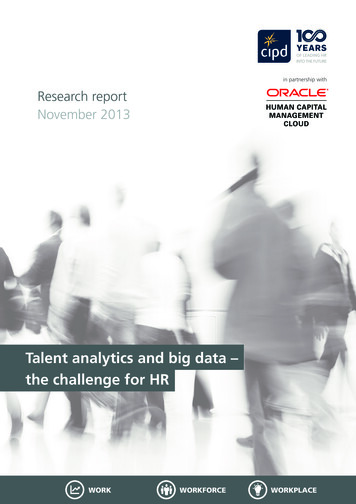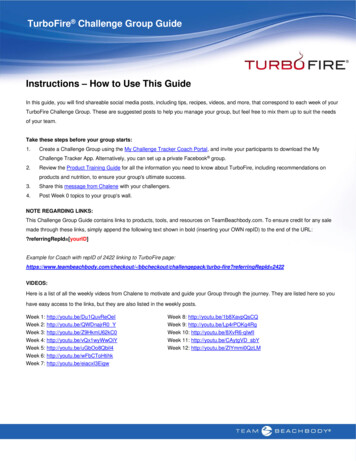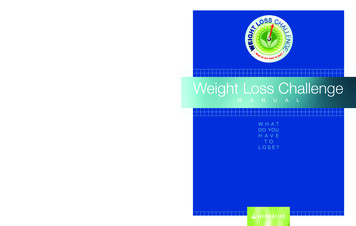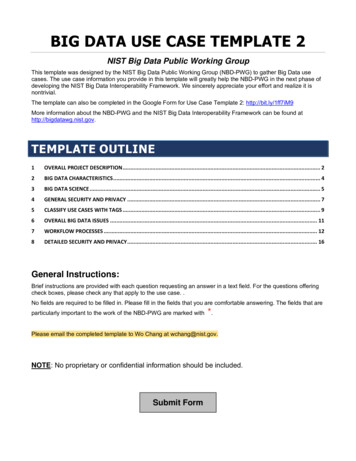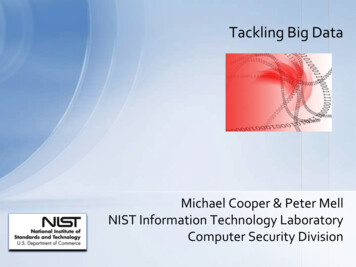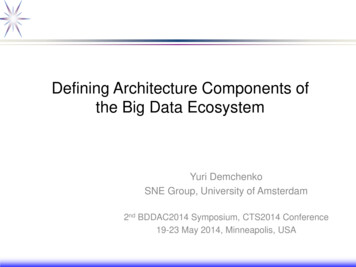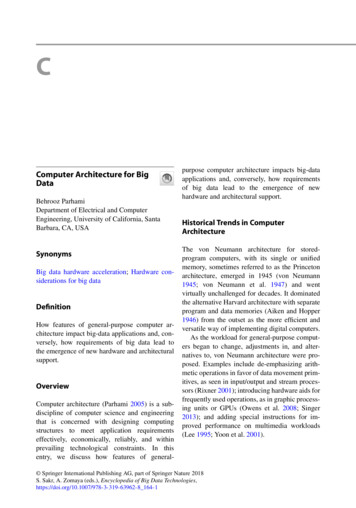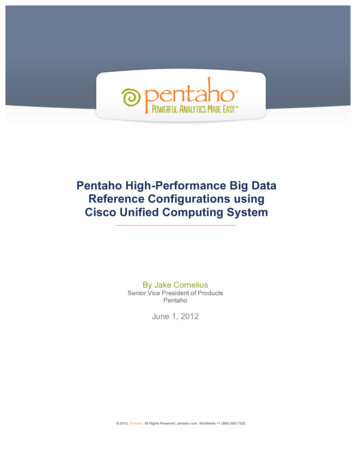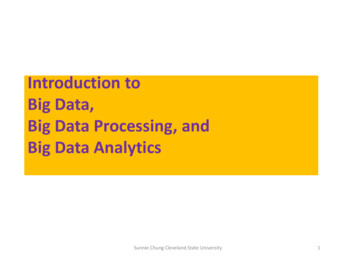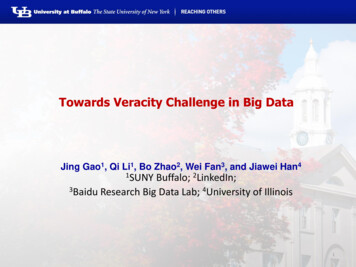
Transcription
Towards Veracity Challenge in Big DataJing Gao1, Qi Li1, Bo Zhao2, Wei Fan3, and Jiawei Han41SUNYBuffalo; 2LinkedIn;3Baidu Research Big Data Lab; 4University of Illinois1
Big data challenge Volume The quantity of generated and stored data2
Big data challenge Velocity The speed at which the data is generated andprocessed3
Big data challenge Variety The type and nature of the data4
Big data challenge Veracity The quality of captured data5
Causes of Veracity Issue Rumors Spammers Collection errors Entry errors System errors 6
Aspects of Solving Veracity Problems Sources and claims We know who claims what Truth discovery Features of sources and claims Features of sources, eg. history, graphs of sources Features of claims, eg. hashtags, lexical patterns Rumor detection Source trustworthiness analysis7
Overview1234567 Introduction Truth Discovery: Veracity Analysis from Sources and Claims Truth Discovery Scenarios Veracity Analysis from Features of Sources and Claims Applications Open Questions and Resources References8
Overview1234567 Introduction Truth Discovery: Veracity Analysis from Sources and Claims Truth Discovery Scenarios Veracity Analysis from Features of Sources and Claims Applications Open Questions and Resources References9
Truth Discovery Problem Input: Multiple conflicting information about thesame set of objects provided by variousinformation sources Goal: Discover trustworthy information (i.e., thetruths) from conflicting data on the same object10
Example 1: Knowledge Base Construction Knowledge base– Construct knowledgebase based on hugeamount of informationon Internet Problem– Find true facts frommultiple conflictingsources11
What Is The Height Of Mount Everest?12/61
13/61
14/61
Example 2: Crowdsourced Question Answering50%30%19%1%ABCDWhich of these square numbers also happens to bethe sum of two smaller square numbers?16253649https://www.youtube.com/watch?v BbX44YSsQ2I15/61
AggregationSource 1Source 2Source 3Source 4Source 516
Aggregation17
A Straightforward Aggregation Solution Voting/Averaging– Take the value that is claimed by majority of thesources– Or compute the mean of all the claims Limitation– Ignore source reliability Source reliability– Is crucial for finding the true fact but unknown18
50%30%19%1%ABCDWhich of these square numbers also happens to be thesum of two smaller square numbers?16253649https://www.youtube.com/watch?v BbX44YSsQ2I19/61
A Straightforward Aggregation Solution Voting/Averaging– Take the value that is claimed by majority of thesources– Or compute the mean of all the claims Limitation– Ignore source reliability Source reliability– Is crucial for finding the true fact but unknown20
Truth Discovery Principle–Infer both truth and source reliabilityfrom the data A source is reliable if it provides many pieces oftrue information A piece of information is likely to be true if it isprovided by many reliable sources21
Model Categories Optimization model (OPT) Statistical model (STA) Probabilistic graphical model (PGM)22
Optimization Model (OPT) General modelarg min𝑔(𝑤𝑠 , 𝑣𝑜 )𝑤𝑠 , 𝑣𝑜 𝑜 𝑂 𝑠 𝑆𝑠. 𝑡. 𝛿1 𝑤𝑠 1, 𝛿2𝑣𝑜 1 What does the model mean? Find the optimal solution that minimize the objectivefunction Jointly estimate true claims 𝑣𝑜 and source reliability 𝑤𝑠under some constraints 𝛿1 , 𝛿2 , . . Function 𝑔 , can be distance, entropy, etc.23
Optimization Model (OPT) General modelarg min𝑔(𝑤𝑠 , 𝑣𝑜 )𝑤𝑠 , 𝑣𝑜 𝑜 𝑂 𝑠 𝑆𝑠. 𝑡. 𝛿1 𝑤𝑠 1, 𝛿2𝑣𝑜 1 How to solve the problem? Use the method of Lagrange multipliers Block coordinate descent to update parameters If each sub-problem is convex and smooth, thenconvergence is guaranteed24
OPT - CRH Framework𝐾min𝒳 ,𝒲𝑓(𝒳 , 𝒲) 𝑁𝑀( ) (𝑘)𝑑𝑚 𝑣𝑖𝑚 , 𝑣𝑖𝑚𝑤𝑘𝑘 1𝑖 1 𝑚 1s. t. 𝛿 𝒲 1,𝒲 0.CRH is a framework that deals with the heterogeneity ofdata. Different data types are considered, and theestimation of source reliability is jointly performed acrossall the data types together.[Li et al., SIGMOD’14]25
OPT - CRH Framework𝐾min𝒳 ,𝒲𝑓(𝒳 , 𝒲) 𝑁𝑀( ) (𝑘)𝑑𝑚 𝑣𝑖𝑚 , 𝑣𝑖𝑚𝑤𝑘𝑘 1𝑖 1 𝑚 1s. t. 𝛿 𝒲 1,𝒲 0.Basic idea Truths should be close to the claims from reliable sourcesMinimize the overall weighted distance to the truths inwhich reliable sources have high weights26
OPT - CRH Framework Loss function 𝑑𝑚 : loss on the data type of the m-th property Output a high score when the claim deviates from the truth Output a low score when the claim is close to the truth Constraint function The objective function may go to without constraints Regularize the weight distribution27
OPT - CRH Framework Run the following until convergence Truth computation Minimize the weighted distance between the truth andthe sources’ claims𝐾 𝑣𝑖𝑚 arg min𝑣𝑤𝑘 𝑘𝑑𝑚 𝑣, 𝑣𝑖𝑚𝑘 1 Source reliability estimation Assign a weight to each source based on the differencebetween the truths and the claims made by the source𝒲 arg min 𝑓(𝒳𝒲 , 𝒲)28
Statistical Model (STA) General goal: To find the (conditional) probability of a claim being true Source reliability: Probability(ies) of a source/worker making a true claim29
Statistical Model (STA) Models Apollo-MLE [Wang et al., ToSN’14] TruthFinder [Yin et al., TKDE’08] Investment, Pool Investment [Pasternack&Roth, COLING’10] Cosine, 2-estimate, 3-estimate [Galland et al., WSDM’10]30
STA - TruthFinderDifferent websites often provide conflicting informationon a subject, e.g., Authors of “Rapid Contextual Design”Online StoreAuthorsPowell’s booksHoltzblatt, KarenBarnes & NobleKaren Holtzblatt, Jessamyn Wendell, Shelley WoodA1 BooksKaren Holtzblatt, Jessamyn Burns Wendell, Shelley WoodCornwall booksHoltzblatt-Karen, Wendell-Jessamyn Burns, WoodMellon’s booksWendell, JessamynLakeside booksWENDELL, JESSAMYNHOLTZBLATT, KARENWOOD, SHELLEYBlackwell onlineWendell, Jessamyn, Holtzblatt, Karen, Wood, Shelley[Yin et al., TKDE’08]31
STA - TruthFinder Each object has a set of conflictive facts E.g., different author lists for a bookAnd each web site provides some facts How to find the true fact for each object? Web sitesFactsw1f1w2w3w4f2Objectso1f3f4o2f532
STA - TruthFinder1. There is usually only one true fact for a property ofan object2. This true fact appears to be the same or similar ondifferent web sites E.g., “Jennifer Widom” vs. “J. Widom”3. The false facts on different web sites are less likelyto be the same or similar False facts are often introduced by random factors4. A web site that provides mostly true facts formany objects will likely provide true facts forother objects33
STA - TruthFinder Confidence of facts Trustworthiness of web sites A fact has high confidence if it is provided by (many)trustworthy web sites A web site is trustworthy if it provides many facts with highconfidence Iterative steps Initially, each web site is equally trustworthy Based on the four heuristics, infer fact confidence from website trustworthiness, and then backwards Repeat until achieving stable state34
STA - TruthFinderWeb sitesFactsw1f1w2f2w3f3w4Objectso1o2f43535
STA - TruthFinderWeb sitesFactsw1f1w2f2w3f3w4Objectso1o2f43636
STA - TruthFinderWeb sitesFactsw1f1w2f2w3f3w4Objectso1o2f43737
STA - TruthFinderWeb sitesFactsw1f1w2f2w3f3w4Objectso1o2f43838
STA - TruthFinder The trustworthiness of a web site 𝒘: 𝒕(𝒘) Average confidence of facts it provides t w f F w s f F w Sum of fact confidenceSet of facts provided by wt(w1)w1 The confidence of a fact 𝒇: 𝒔(𝒇) One minus the probability that all web sitesproviding f are wrongt(w2)Probability that w is wrongw2s f 1 1 t w w W fs(f1)f1 Set of websites providing f39
Probabilistic Graphical Model (PGM)Source reliabilityTruth40
Probabilistic Graphical Model (PGM) Models GTM [Zhao&Han, QDB’12] LTM [Zhao et al., VLDB’12] MSS [Qi et al., WWW’13] LCA [Pasternack&Roth, WWW’13] TEM [Zhi et al., KDD’15] 41
PGM – Gaussian Truth Model (GTM) Real-valued Truths and Claims Population of a city is numerical The quality of sources is modeled as how close theirclaims are to the truth Distance is better than accuracy for numerical data Sources and objects are independent respectively[Zhao&Han, QDB’12]42
PGM – Gaussian Truth Model (GTM)Quality of SourcesClaimsTruth of Facts43
PGM – Gaussian Truth Model (GTM) For each source 𝑘 Generate its quality from a prior inverse Gamma distribution :𝜎𝑠2 𝐼𝑛𝑣 𝐺𝑎𝑚𝑚𝑎 𝛼, 𝛽 For each fact 𝑓 Generate its prior truth from a prior Gaussian distribution:𝜇𝑒 𝐺𝑎𝑢𝑠𝑠𝑖𝑎𝑛 𝜇0 , 𝜎02 For each claim 𝑐 of fact 𝑓, generate claim of 𝑐. Generate it from a Gaussian distribution with truth as mean andthe quality as variance: 𝑜𝑐 𝐺𝑎𝑢𝑠𝑠𝑖𝑎𝑛 𝜇𝑒 , 𝜎𝑠2𝑐44
Overview1234567 Introduction Truth Discovery: Veracity Analysis from Sources and Claims Truth Discovery Scenarios Veracity Analysis from Features of Sources and Claims Applications Open Questions and Resources References45
Number of Truths for One Object Single truth Each object has one and only one truth The claims from sources contain the truth Complementary vote Multiple truth Each object may have more than true fact Each source may provide more than one fact for each object Existence of truths The true fact for an object may be not presented by anysources46
Single Truth Example A person’s birthday Population of a city Address of a shop Complementary vote If a source makes a claim on an object, that source considersall the other claims as false Positive vote only [Wang et al., ToSN’14] An event only receive positive claims, but no negativeclaims. E.g., people only report that they observe an event.47
Multiple Truth- Latent Truth Model (LTM) Multiple facts can be true for each entity (object) One book may have 2 authors A source can make multiple claims per entity, wheremore than one of them can be true A source may claim a book w. 3 authors Source reliability False positive: making a wrong claim Sensitivity: missing a claim Modeled in PGM[Zhao et al., VLDB’12]48
Multiple Truth- Latent Truth Model (LTM)False positive ratesensitivityTruth of Facts49
Multiple Truth- Latent Truth Model (LTM) For each source 𝑘 Generate false positive rate (with strong regularization, believing mostsources have low FPR): 𝜙𝑘0 𝐵𝑒𝑡𝑎 𝛼0,1 , 𝛼0,0 Generate its sensitivity (1-FNR) with uniform prior, indicating low FNR ismore likely: 𝜙𝑘1 𝐵𝑒𝑡𝑎 𝛼1,1 , 𝛼1,0 For each fact 𝑓 Generate its prior truth prob, uniform prior: 𝜃𝑓 𝐵𝑒𝑡𝑎 𝛽1 , 𝛽0 Generate its truth label: 𝑡𝑓 𝐵𝑒𝑟𝑛𝑜𝑢𝑙𝑙𝑖 𝜃𝑓 For each claim 𝑐 of fact 𝑓, generate claim of 𝑐. If 𝑓 is false, use false positive rate of source:𝑜𝑐 𝐵𝑒𝑟𝑛𝑜𝑢𝑙𝑙𝑖 𝜙𝑠0𝑐 If 𝑓 is true, use sensitivity of source: 𝑜𝑐 𝐵𝑒𝑟𝑛𝑜𝑢𝑙𝑙𝑖 𝜙𝑠1𝑐50
Existence of Truth Truth Existence problem: when the true answers areexcluded from the candidate answers provided by allsources. Has-truth questions: correct answers exist among thecandidate answers provided by all sources. No-truth questions: true answers are not included in thecandidate answers provided by all sources. Without any prior knowledge, the no-truth questionsare hard to distinguish from the has-truth ones. These no-truth questions degrade the precision of theanswer integration system. Example: Slot Filling Task[Yu et al., COLING’14][Zhi et al., KDD’15]51
Existence of TruthExample: Slot Filling Task52
Existence of Truth53Has-truthquestionsNo-truth questions
Existence of Truth - Truth Existence Model(TEM) Probabilistic Graphical Model Output 𝑡: latent truths 𝜙 : source quality Input A: observed answers S: sources Parameters (fixed) Prior of source quality: 𝛼 Prior of truth: 𝜂𝜂𝑖0 𝑃 𝑡𝑖 𝐸 , 𝜂𝑖𝑛 𝑃 𝑡𝑖 𝑑𝑖𝑛 Maximum Likelihood Estimation Inference: EM54
Source Dependency Many truth discovery methods considers independentsources Sources provide information independently Source correlation can be hard to model However, this assumption may be violated in real life Copy relationships between sources Sources can copy information from one or more othersources General correlations of sources55
Source Dependency Known relationships Apollo-Social [Wang et al., IPSN’14] For a claim, a source may copy from a related source with a certainprobability Used MLE to estimate a claim being correct Unknown relationships Accu-Copy [Dong et al., VLDB’09a] [Dong et al., VLDB’09b] MSS [Qi et al., WWW’13] Modeled as a PGM Related sources are grouped together and assigned with a groupweight56
Copy Relationships between Sources High-level intuitions for copying detection Common error implies copying relation e.g., many same errors in 𝑠1 𝑠2 imply source 1 and 2 arerelated Source reliability inconsistency implies copy direction e.g., 𝑠1 𝑠2 and 𝑠1 𝑠2 has similar accuracy, but 𝑠1 𝑠2 and𝑠2 𝑠1 has different accuracy, so source 2 may be a copier.Objects covered Common Objects coveredby source 1 butobjects by source 2 butnot by source 2not by source 1𝑠1 𝑠2𝑠1 𝑠2𝑠2 𝑠157
Copy Relationships between Sources Incorporate copying detection in truth discoveryStep tectionStep 3Step 1[Dong et al., VLDB’09a] [Dong et al., VLDB’09b]58
General Source Correlation More general source correlations Sources may provide data from complementary domains(negative correlation) Sources may focus on different types of information(negative correlation) Sources may apply common rules in extraction (positivecorrelation) How to detect Hypothesis test of independence using joint precision andjoint recall[Pochampally et al., SIGMOD’14]59
Information Density Dense information Each source provides plenty of claims Each object receives plenty of information from sources Long-tail phenomenon on sources side Many sources provide limited information Only a few sources provide sufficient information Auxiliary information Text of question/answers Fine-grained source reliability estimation60
Long-tail Phenomenon on Sources Side61
Long-tail Phenomenon on Sources Side CATD Challenge when most sources make a few claims Sources weights are usually estimated as proportional to theaccuracy of the sources If long-tail phenomenon occurs, most source weights are notproperly estimated. A confidence-aware approach not only estimates source reliability but also considers the confidence interval of the estimation An optimization based approach[Li et al., VLDB’15]62
Long-tail Phenomenon on Sources Side CATD Assume that sources are independent and error madeby source 𝑠: 𝜖𝑠 𝑁 0, 𝜎𝑠2 𝜖𝑎𝑔𝑔𝑟𝑒𝑔𝑎𝑡𝑒 𝑠 𝑆 𝑤𝑠 𝜖𝑠𝑠 𝑆 𝑤𝑠 𝑁 0,2 2𝑠 𝑆 𝑤𝑠 𝜎𝑠2𝑠 𝑆 𝑤𝑠Without loss of generality, we constrain Optimization𝑠 𝑆 𝑤𝑠 163
Long-tail Phenomenon on Sources Side CATDSample variance:12𝜎𝑠 𝑁𝑠 (0)𝑥𝑛𝑥𝑛𝑠 (0) 2𝑥𝑛𝑛 𝑁𝑠whereis the initial truth.The estimation is not accurate with small number ofsamples.Find a range of values that can act as good estimates.Calculate confidence interval based on𝑁𝑠 𝜎𝑠2𝜎𝑠2 𝜒 2 𝑁𝑠64
Long-tail Phenomenon on Sources Side CATD Consider the possibly worst scenario of 𝜎𝑠2 Use the upper bound of the 95% confidenceinterval of 𝜎𝑠22 0𝑠𝑥𝑛 𝑥𝑛𝑛 𝑁𝑠𝑢𝑠2 𝜒 20.05, 𝑁𝑠65
Long-tail Phenomenon on Sources Side CATD Closed-form solution:1𝑤𝑠 2 𝑢𝑠𝜒 20.05, 𝑁𝑠𝑛 𝑁𝑠𝑥𝑛𝑠 0𝑥𝑛266
Long-tail Phenomenon on Sources Side CATDExample on calculating confidence interval67
Long-tail Phenomenon on Sources Side CATDExample on calculating source weight68
Long-tail Phenomenon on Sources Side CATDHigher levelindicatesharderquestionsQuestionlevelError rate ofMajorityVotingError rate 30430.130490.37370.1414100.52270.204569
Fine-Grained Truth Discovery - FaitCrowd To learn fine-grained (topical-level) user expertise and thetruths from conflicting crowd-contributed answers. Topic is learned from question&answer textsPoliticsPhysicsMusic[Ma et al., KDD’15]70
Fine-Grained Truth Discovery - FaitCrowd Input Question Set User Set Answer Set Question 2deq521efq612df2Topic Output Questions’ Topic Topical-Level Users’Expertise 3q4q5q6Truth121212Questionq1q2q3q4q5q6Ground Truth12121712
Fine-Grained Truth Discovery - FaitCrowd OverviewModeling Content yqm wqmModeling AnswersuzqMq 'aqu ' InputOutputNqbqQ 2'eK qtqK U 2HyperparameterIntermediateVariable Jointly modeling question content and users’ answers by introducinglatent topics. Modeling question content can help estimate reasonable userreliability, and in turn, modeling answers leads to the discovery ofmeaningful topics. Learning topics, topic-level user expertise and truths simultaneously.72
Fine-Grained Truth Discovery - FaitCrowd Answer Generation The correctness of a user’s answermay be affected by the question’stopic, user’s expertise on the topicand the question’s bias. Draw user’s expertise yqm wqmuzqMq 'aqu ' NqbqQ 2'eK qtqK U 273
Fine-Grained Truth Discovery - FaitCrowd Answer Generation The correctness of a user’s answermay be affected by the question’stopic, user’s expertise on the topicand the question’s bias. Draw user’s expertise Draw the truth yqm wqmuzqMq 'aqu ' NqbqQ 2'eK qtqK U 274
Fine-Grained Truth Discovery - FaitCrowd Answer Generation The correctness of a user’s answermay be affected by the question’stopic, user’s expertise on the topicand the question’s bias. Draw user’s expertise Draw the truth Draw the bias yqm wqmuzqMq 'aqu ' NqbqQ 2'eK qtqK U 275
Fine-Grained Truth Discovery - FaitCrowd Answer Generation The correctness of a user’s answermay be affected by the question’stopic, user’s expertise on the topicand the question’s bias. Draw user’s expertise Draw the truth Draw the bias yqm wqmuzqMq 'aqu ' NqbqQ 2'eK qtqK U 2 Draw a user’s answer76
Fine-Grained Truth Discovery - 090.37370.14140.1010100.52270.20450.113677
Real Time Truth Discovery - DynaTD Source reliability evolves over time Update source reliability based on continuouslyarriving data:𝑠𝑠𝑝 𝑤𝑠 𝑒1:𝑇 𝑝 𝑒𝑇𝑠 𝑤𝑠 𝑝(𝑤𝑠 𝑒1:𝑇 1)[Li et al., KDD’15]78
Overview1234567 Introduction Truth Discovery: Veracity Analysis from Sources and Claims Truth Discovery Scenarios Veracity Analysis from Features of Sources and Claims Applications Open Questions and Resources References79
Veracity Analysis from Features of Sourcesand Claims Rumor detection Find the rumor Find the source of the rumor Source trustworthiness analysis Graph based model Learning based model80
Rumor Detection on Twitter Clues for Detecting Rumors Burst High retweet ratio Clue words[Takahashi&Igata, SCIS’12]81
Rumor Detection – Find the Rumor Content-based features Lexical patterns Part-of-speech patterns Network-based features Tweeting and retweeting history Microblog-specific memes Hashtags URLs Mentions[Qazvinian et al., EMNLP’11][Ratkiewicz et al., CoRR’10]82
Rumor Detection on Sina Weibo Content-based features Has multimedia, sentiment, has URL, time span Network-based features Is retweeted, number of comments, number of retweets Client Client program used Account Gender of user, number of followers, user name type, Location Event location[Yang et al., MDS’12]83
Rumor Detection – Find the Source Graph G If u infected, v not,and u-v, u will infect vafter delay exp(λ) Note: everyone willbe infected, just amatter of cted13542354[Shah&Zaman, SIGMETRICS’12]84
Centrality Measures How “important” or central isa node u? Rank or measure withtopological properties Degree Eigenvector Pagerank Betweenness The fraction of all shortest pathsthat a node u is on Closeness Average of shortest distances fromu to other nodes Equal to rumor centrality for trees85
Rumor Source Detection – Rumor Centrality Known infinite regular tree G,degree d 1 exp(λ) transmission times Each edge has iid random draw Value is the same for either direction At an unknown time t, youobserve the state of the network. Which node was the source of theinfection? Idea: Compute rumor centralityfor each node in infectedsubgraph; take highest rankingnodeGraph G at time t 87
Rumor Source Detection – Rumor Suspects Here you also have an a prioriset of suspects S Which suspect was thesource of the infection?S Idea: Compute rumorcentrality like before, buttake highest ranking node inS[Dong et al., ISIT’13]Graph G at time t88
Rumor Source Detection – MultipleObservations Here you have multipleobservations of independentrumor spreads, with the samesource. Idea: Compute rumorcentrality for each graph, takeproduct[Wang et al., SIGMETRICS’14]89
Source Trustworthiness – Graph-Based Intuition A page has a high trustworthiness if its backlinks aretrustworthy Only use source linkage[Page et al., 1999][Kleinberg, JACM’99]90
Source Trustworthiness – EigenTrust Problem in P2P: Inauthentic files distributed by malicious nodes Objective: Identify the source of inauthentic files and biasagainst downloading from them Basic Idea Each peer has a Global Reputation given by the localtrust values assigned by other peers[Kamvar et al., WWW’03]91
Source Trustworthiness – EigenTrust Local trust value 𝑐𝑖𝑗 The opinion peer 𝑖 has of peer 𝑗, based on pastexperiences Each time peer 𝑖 downloads anauthentic/inauthentic file from peer 𝑗, 𝑐𝑖𝑗increases/decreases. Global trust value 𝑡𝑖 The trust that the entire system places in peer 𝑖What their opinion of peer kAsk friend jWeight your friend’s opinion byhow much you trust them92
Source Trustworthiness – Learning-Based Trust prediction: classification problem Trust: positive class Not trust: negative class Features Extracted from sources to represent pairs of users93
Source Trustworthiness – User Pair Trust Developed extensive list of possible predictive variables fortrust between users User factors Interaction factors Epinions Write reviews Rate reviews Post comments Used several ML tools Decision treeNaïve BayesSVMLogistic regression Interaction factors are important to predict trust[Liu et al., EC’08]94
Overview1234567 Introduction Truth Discovery: Veracity Analysis from Sources and Claims Truth Discovery Scenarios Veracity Analysis from Features of Sources and Claims Applications Open Questions and Resources References95
Applications Knowledge base construction Slot filling Social media data analysis Rumor/fraud detection, rumor propagation Claim aggregation Mobile sensing Environmental monitoring Wisdom of the crowd Community question answering systems96
Mobile SensingHuman Sensor97
PM2.5 value?e198
250198e127599
Health-Oriented Community QuestionAnswering Systems100
Quality of Question-Answer Thread101
Quality of Question-Answer Thread102
Quality of Question-Answer Thread103
Quality of Question-Answer Thread104
Quality of Question-Answer Thread105
Quality of Question-Answer ThreadTruth Discovery106
Challenge (1): Noisy Input Raw textual data, unstructured Error introduced by extractor107
Challenge (2): Long-tail PhenomenonNumber of ObjectsNumber of Sources Long-tail on both object and source sides Most questions have few answersNumber of ClaimsNumber of Claims108
Challenge (3): Multiple Linked Truths Truths can be multiple, and they are correlated witheach othercough,feverBronchitisColdTuberculosis109
Challenge (4): Efficiency Issue Truth Discovery iterative procedureInitialize Weights of SourcesTruthComputationSourceWeightEstimationTruth and Source Weights Medical QA large-scale dataOne Chinese Medical Q&Aforum: millions of registeredpatients hundreds of thousandsof doctors thousands of newquestions per day110
Overview of Our SystemFilteringraw Dataapplication Q, A pairsEntityExtractionsymptoms,diseases,drugs, etcExtractedKnowledge111
Q&A System25-year-old,cough, feverExtractedKnowledgeby OurSystemBronchitisCold45%25%Tuberculosis30%112
Q&A System25-year-old,cough, feverExtractedKnowledgeby TuberculosisRifampin30%113
Overview1234567 Introduction Truth Discovery: Veracity Analysis from Sources and Claims Truth Discovery Scenarios Veracity Analysis from Features of Sources and Claims Applications Open Questions and Resources References115
Open Questions Data with complex types and structures Theoretical analysis Efficiency of veracity analysis Interpretation and evaluation Application-specific challenges116
Available Resources Survey for truth discovery [Gupta&Han, 2011] [Li et al., VLDB’12] [Waguih et al., 2014] [Waguih et al., ICDE’15] [Li et al., 2016] Survey for source trustworthiness analysis [Tang&Liu, WWW’14]117
Available Resources Truth discovery data and code http://lunadong.com/fusionDataSets.htm http://cogcomp.cs.illinois.edu/page/resource view/16 http://www.cse.buffalo.edu/ jing/software.htm118
These slides are available athttp://www.cse.buffalo.edu/ jing/talks.htm KDD’16 TutorialEnabling the Discovery of Reliable Information from Passivelyand Actively Crowdsourced Data-Budget allocation-Privacy preservation-Crowd sensing- .119
References[Li et al., VLDB’14] Q. Li, Y. Li, J. Gao, B. Zhao, W. Fan, and J. Han. ResolvingConflicts in heterogeneous data by truth discovery and source reliabilityestimation. In Proc. of the ACM SIGMOD International Conference onManagement of Data, pages 1187–1198, 2014.[Wang et al., ToSN’14] D. Wang, L. Kaplan, and T. F. Abdelzaher. Maximumlikelihood analysis of conflicting observations in social sensing. ACMTransactions on Sensor Networks (ToSN’14), 10(2):30, 2014.[Pasternack&Roth, COLING’10] J. Pasternack and D. Roth. Knowing what tobelieve (when you already know something). In Proc. of the InternationalConference on Computational Linguistics (COLING’10), pages 877–885,2010.[Galland et al., WSDM’10] A. Galland, S. Abiteboul, A. Marian, and P.Senellart. Corroborating information from disagreeing views. In Proc. ofthe ACM International Conference on Web Search and Data Mining(WSDM'10), pages 131–140, 2010.120
[Yin et al., TKDE’08] X. Yin, J. Han, and P. S. Yu. Truth discovery withmultiple conflicting information providers on the web. IEEE Transactionson Knowledge and Data Engineering, 20(6): 796–808, 2008.[Zhao&Han, QDB’12] B. Zhao, and J. Han. A probabilistic model forestimating real-valued truth from conflicting sources. In Proc. of the VLDBworkshop on Quality in Databases (QDB’12), 2012.[Zhao et al., VLDB’12] B. Zhao, B. I. P. Rubinstein, J. Gemmell, and J. Han. ABayesian approach to discovering truth from conflicting sources for dataintegration. PVLDB, 5(6):550–561, Feb. 2012.[Qi et al., WWW’13] G.-J. Qi, C. C. Aggarwal, J. Han, and T. Huang. Miningcollective intelligence in diverse groups. In Proc. of the InternationalConference on World Wide Web (WWW’13), pages 1041–1052, 2013.[Pasternack&Roth, WWW’13] J. Pasternack and D. Roth. Latent credibilityanalysis. In Proc. of the International Conference on World Wide Web(WWW’13), pages 1009–1020, 2013.[Zhi et al., KDD’15] S. Zhi, B. Zhao, W. Tong, J. Gao, D. Yu, H. Ji, and J. Han.Modeling truth existence in truth discovery. In Proc. of the ACM SIGKDDInternational Conference on Knowledge Discovery and Data Mining(KDD’15), 2015.121
[Yu et al., COLING’14] D. Yu, H. Huang, T. Cassidy, H. Ji, C. Wang, S. Zhi, J.Han, C. Voss, and M. Magdon-Ismail. The wisdom of minority:Unsupervised slot filling validation based on multi-dimensional truthfinding. In Proc. of the International Conference on ComputationalLinguistics (COLING’14), 2014.[Wang et al., IPSN’14] D.Wang, M. T. Amin, S. Li, T. Abdelzaher, L. Kaplan, S.Gu, C. Pan, H. Liu, C. C. Aggarwal, R. Ganti, et al. Using humans as sensors:An estimation-theoretic perspective. In Proc. of the InternationalConference on Information Processing in Sensor Networks (IPSN'14), pages35–46, 2014.[Dong et al., VLDB’09a] X. L. Dong, L. Berti-Equille,and D. Srivastava.Integrating conflicting data: The role of source dependence. PVLDB, pages550–561, 2009.[Dong et al., VLDB’09b] X. L. Dong, L. Berti-Equille,and D. Srivastava. Truthdiscovery and copying detection in a dynamic world. PVLDB, pages 550–561, 2009.[Pochampally et al., SIGMOD’14] R. Pochampally, A. D. Sarma, X. L. Dong,A. Meliou, and D. Srivastava. Fusing data with correlations. In Proc. of theACM SIGMOD International Conference on Management of Data, pages433–444, 2014.122
[Li et al., VLDB’12] X. Li, X. L. Dong, K. B. Lyons, W. Meng, and D. Srivastava.Truth finding on the deep web: Is the problem solved? PVLDB, 6(2):97–108, 2012.[Li et al., VLDB’15] Q. Li, Y. Li, J. Gao, L. Su, B. Zhao, M. Demirbas, W. Fan,and J. Han. A confidence-aware approach for truth discovery on long-taildata. PVLDB, 8(4), 2015.[Ma et al., KDD’15] F. Ma, Y. Li, Q. Li, M. Qui, J. Gao, S. Zhi, L. Su, B. Zhao, H.Ji, and J. Han. Faitcrowd: Fine grained truth discovery for crowdsourceddata aggregation. In Proc. of the ACM SIGKDD International Conference onKnowledge Discovery and Data Mining (KDD’15), 2015.[Li et al., KDD’15] Y. Li, Q. Li, J. Gao, L. Su, B. Zhao, W. Fan, and J. Han. Onthe Discovery of Evolving Truth. In Proc. of ACM SIGKDD Conference onKnowledge Discovery and Data Mining (KDD'15), 2015.[Qazvinian et al., EMNLP’11] V. Qazvinian, E. Rosengren, D. R. Radev, andQ. Mei. Rumor has i
3Baidu Research Big Data Lab; 4University of Illinois 1 . A1 Books Karen Holtzblatt, Jessamyn Burns Wendell, Shelley Wood Cornwall books Holtzblatt-Karen, Wendell-Jessamyn Burns, Wood Mellon’s books Wendell, Jessamyn Lakeside books
